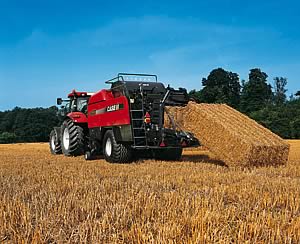 |
|||||||||
|
|||||||||||||||||||
|
|
Straw Can Play an Important Role This Winter After such a variable season, good quality forage is at a premium this winter. Many farmers in certain areas are having to ration silage and hay stocks to ensure they have enough to last the winter, which means some are adding straw to bulk out the forage part of the diet. However there are some areas of the country where straw is the only forage option available, says Tom Butler, Technical Product Manager for the Denis Brinicombe Group.
Although straw can be a useful addition to the diet it is not the preferred choice of forage for growth and production. Traditionally straw is often used because of its low digestibility rate and has the effect of slowing the throughput of less fibrous feeds in the rumen. In general terms it has a low feed value which is reflected in the energy and protein content. However if it is being used as the sole source of forage then the digestibility can be improved but at the same time the remainder of the ration needs to be carefully balanced, warns Mr Butler. Straw fed animals have a higher demand for rumen degradable protein to enable them to digest the fibre and maximise available feed value which in turn will encourage a higher dry matter intake. This can be achieved by including a urea based protein liquid feed in the diet which should be offered on a little and often basis. Historically farmers may have soaked straw bales with a molasses type liquid but this in effect will only improve palatability and not digestibility and it should be recognised that the two are quite different. Improving palatability will only ever be a short term fix to improve intakes as unless digestibility is improved and maintained, intakes will wane and performance will be affected. By providing the correct liquid feed from a ball feeder the animal can balance its needs in direct relation to the inevitable quality variation of the forage it is eating at that particular time. It also means that it can balance its own forage ration 24 hours/day which no other feeding system can offer as effectively. As ruminants naturally eat on a little and often basis, this free access feeding meets the demand of the forage digesting rumen bugs by supplying them with a constant supply of rumen degradable protein (urea) and readily fermentable energy (sucrose) which are the building blocks to maintaining appetite and maximising dry matter intake. Another key advantage is that a molasses liquid will not compete for rumen space and displace forage which regardless of quality is always the cheaper part of the ration. Particular attention should also be given to the animals’ mineral status whilst feeding straw due to its lower content of key elements and the impact this can have on performance. Advice should always be taken and consideration should also be given to the local farm conditions and historical deficiencies that may occur. Undoubtedly there is a greater awareness and interest in liquid feed this year because of the shortage in quality forage but it is essential that the correct nutritional advice is sought prior to substituting silage with straw. If this is done then having poorer quality forage in the ration need not mean reduced production and profit, concludes Mr Butler.
|
||||||||||||||||||

|
|
||||||||||||||||||
| home | agri-services | pedigree
pen | news | dairy | beef | machinery quota | property | organisations | site map |
|||||||||||||||||||

